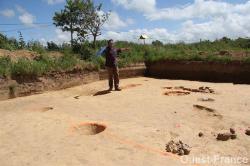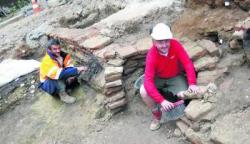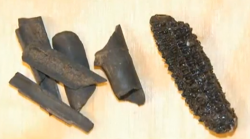INSTITUT SUPERIEUR D'ANTHROPOLOGIE
INSTITUTE OF ANTHROPOLOGY
ONLINE COURSES / COURS A DISTANCE
SUMMER TERM : JULY 2013
REGISTER NOW
FRANCE –  Le Rusquet - Des fouilles archéologiques ont permis de découvrir des traces de l'âge de bronze, il y a 3 800 ans, à l'emplacement de la future zone de Pégase V. Une ferme de l'époque gallo-romaine a aussi été mise au jour. Depuis le 18 mars, des archéologues ont remué les 3,5 ha de terre, scruté ses couleurs pour déceler les emplacements des antiques fossés et réussi à dresser une carte du site. Il en ressort que le site de Penn-an-Ale a été habité à l'âge de bronze. Des traces de deux maisons ont été mises au jour. L'une d'elle, toute proche de la route vers Louannec, est particulièrement intéressante. Des morceaux de vases y ont été retrouvés enfouis, si les labours passés ont écrêté leurs sommets, leurs bases sont bien là, en morceaux. Dans cette maison, les archéologues ont trouvé une petite fosse, les traces d'un foyer et de la petite meule d'un métallurgiste. « Mais, on ne trouve pas de morceaux de bronze, trop précieux pour être jetés », note Stéphane Blanchet, l'archéologue de l'Inrap (institut national de recherche archéologique préventive) qui a dirigé ces fouilles. La cartographie du site montre qu'à cette époque (entre -1 800 et -1 000 av JC), les chemins contournaient les arbres et de petits fossés « bien organisés » délimitaient les parcelles. Une ferme de l'Antiquité du Ier et IIe siècle a aussi été découverte, avec son enclos d'habitat (maison, dépotoir, puits, caves, citerne) et son enclos agraire (grange, séchoir à grain, pacage des animaux) sur un terrain inoccupé depuis l'âge du bronze. « Ce site est différent de celui de Bel-Air qui montrait des traces d'une société très hiérarchisée. Ce n'est pas le cas ici, la ferme est familiale. » Des traces d'amphores attestent d'un commerce, mais des mystères demeurent. Cette ferme avait-elle un lien avec une villa ?
Le Rusquet - Des fouilles archéologiques ont permis de découvrir des traces de l'âge de bronze, il y a 3 800 ans, à l'emplacement de la future zone de Pégase V. Une ferme de l'époque gallo-romaine a aussi été mise au jour. Depuis le 18 mars, des archéologues ont remué les 3,5 ha de terre, scruté ses couleurs pour déceler les emplacements des antiques fossés et réussi à dresser une carte du site. Il en ressort que le site de Penn-an-Ale a été habité à l'âge de bronze. Des traces de deux maisons ont été mises au jour. L'une d'elle, toute proche de la route vers Louannec, est particulièrement intéressante. Des morceaux de vases y ont été retrouvés enfouis, si les labours passés ont écrêté leurs sommets, leurs bases sont bien là, en morceaux. Dans cette maison, les archéologues ont trouvé une petite fosse, les traces d'un foyer et de la petite meule d'un métallurgiste. « Mais, on ne trouve pas de morceaux de bronze, trop précieux pour être jetés », note Stéphane Blanchet, l'archéologue de l'Inrap (institut national de recherche archéologique préventive) qui a dirigé ces fouilles. La cartographie du site montre qu'à cette époque (entre -1 800 et -1 000 av JC), les chemins contournaient les arbres et de petits fossés « bien organisés » délimitaient les parcelles. Une ferme de l'Antiquité du Ier et IIe siècle a aussi été découverte, avec son enclos d'habitat (maison, dépotoir, puits, caves, citerne) et son enclos agraire (grange, séchoir à grain, pacage des animaux) sur un terrain inoccupé depuis l'âge du bronze. « Ce site est différent de celui de Bel-Air qui montrait des traces d'une société très hiérarchisée. Ce n'est pas le cas ici, la ferme est familiale. » Des traces d'amphores attestent d'un commerce, mais des mystères demeurent. Cette ferme avait-elle un lien avec une villa ?
http://www.lannion-perros.maville.com/actu/actudet_-Le-Rusquet-a-l-age-de-bronze-c-etait-comment-_une-2355468_actu.Htm
FRANCE –  Moissac - Débutées lundi dernier, les recherches archéologiques semblent prometteuses. Outre une semelle de chaussure en cuir, les premières découvertes portent sur un puits, des murs d’habitation et des accessoires, notamment des fragments d’objets de la vie quotidienne. «Toutes ces trouvailles datent de la fin du Moyen-Âge», explique Patrice Georges, responsable des fouilles pour l’Inrap. Selon ce dernier, le potentiel de ces recherches est énorme. «Dès 50 centimètres de profondeur, faire de telles découvertes, surtout en ville, c’est très prometteur pour la suite, poursuit l’archéologue. Il y a de fortes chances qu’on trouve des éléments plus anciens.» Peut-être même des découvertes qui permettront d’en savoir plus sur les origines de la cité uvale, qui demeurent floues à de nombreux égards.
Moissac - Débutées lundi dernier, les recherches archéologiques semblent prometteuses. Outre une semelle de chaussure en cuir, les premières découvertes portent sur un puits, des murs d’habitation et des accessoires, notamment des fragments d’objets de la vie quotidienne. «Toutes ces trouvailles datent de la fin du Moyen-Âge», explique Patrice Georges, responsable des fouilles pour l’Inrap. Selon ce dernier, le potentiel de ces recherches est énorme. «Dès 50 centimètres de profondeur, faire de telles découvertes, surtout en ville, c’est très prometteur pour la suite, poursuit l’archéologue. Il y a de fortes chances qu’on trouve des éléments plus anciens.» Peut-être même des découvertes qui permettront d’en savoir plus sur les origines de la cité uvale, qui demeurent floues à de nombreux égards.
http://www.ladepeche.fr/article/2013/06/14/1649358-moissac-fouilles-archeologiques-bien-plus-qu-une-sandale.html
BULGARIE –  Perperikon - Bulgarian archaeologist Nikolai Ovcharov said on June 13 that the summer digs at the Perperikon site would go as scheduled after his team received government funding. In March, after the resignation of the Boiko Borissov cabinet, Ovcharov warned that the political upheaval could delay the start of work. The digs will be carried out until mid-September, but should the state subsidy increase at any point during the summer, the tempo of work would increase accordingly, he said. Perperikon, in Bulgaria’s eastern Rhodopes region, about 15km from the town of Kurdjali, has been the site of various forms of religious activity from about 7000 years ago, having first been used by the Thracians. The site is a popular tourist attraction and long-term archaeological work continues to unveil new discoveries. “Those several hundred square metres of the acropolis left to survey may be hiding some of the biggest secrets, we believe,” Ovcharov told Nova Televisia’s breakfast TV show. That particular area of the acropolis held a large altar dating back to the first millennium BCE, a late antiquity Roman temple, as well as the medieval bishop’s palace (13th-14th century), he said.
Perperikon - Bulgarian archaeologist Nikolai Ovcharov said on June 13 that the summer digs at the Perperikon site would go as scheduled after his team received government funding. In March, after the resignation of the Boiko Borissov cabinet, Ovcharov warned that the political upheaval could delay the start of work. The digs will be carried out until mid-September, but should the state subsidy increase at any point during the summer, the tempo of work would increase accordingly, he said. Perperikon, in Bulgaria’s eastern Rhodopes region, about 15km from the town of Kurdjali, has been the site of various forms of religious activity from about 7000 years ago, having first been used by the Thracians. The site is a popular tourist attraction and long-term archaeological work continues to unveil new discoveries. “Those several hundred square metres of the acropolis left to survey may be hiding some of the biggest secrets, we believe,” Ovcharov told Nova Televisia’s breakfast TV show. That particular area of the acropolis held a large altar dating back to the first millennium BCE, a late antiquity Roman temple, as well as the medieval bishop’s palace (13th-14th century), he said.
http://sofiaglobe.com/2013/06/13/archaeological-dig-at-bulgarias-perperikon-to-begin-on-schedule/
USA –  San José - Archaeologists unearthed skeletal remains in unmarked redwood caskets from a pauper’s graveyard Thursday morning, the final stretch of an excavation to ready the site for a nearby hospital’s expansion. They found a clay smoking pipe, a wool jacket, an assortment of pocket knives and spectacles, among other personal items buried with the 1,400 or so bodies in the unmarked potter’s field, according to Santa Clara County spokesperson Joy Alexiou. “In addition to personal items, medical items have also been excavated from the site,” Alexiou says. “Because the ability to sanitize syringes and other medical items was not as effective as it is today, it was a common practice to bury these kinds of items or simply throw them away.” Construction workers first discovered the site last year while working on the foundation for a new building for the Santa Clara Valley Medical Center in downtown San Jose. More than 630 remains have been dug up so far, none with identifying marks, the county says. Most of those buried are men between 23 and 60-plus years old. The smaller share of remains belonged to women, children and infants. Lab tests have shown that some of those buried at the site died of syphilis. Others had amputations. Many may have suffered fatal complications from diabetes. Judging by the hexagon-shaped coffins, the bodies were buried between the late 1800s and 1920s, Alexiou says, left behind because no one claimed the bodies.
San José - Archaeologists unearthed skeletal remains in unmarked redwood caskets from a pauper’s graveyard Thursday morning, the final stretch of an excavation to ready the site for a nearby hospital’s expansion. They found a clay smoking pipe, a wool jacket, an assortment of pocket knives and spectacles, among other personal items buried with the 1,400 or so bodies in the unmarked potter’s field, according to Santa Clara County spokesperson Joy Alexiou. “In addition to personal items, medical items have also been excavated from the site,” Alexiou says. “Because the ability to sanitize syringes and other medical items was not as effective as it is today, it was a common practice to bury these kinds of items or simply throw them away.” Construction workers first discovered the site last year while working on the foundation for a new building for the Santa Clara Valley Medical Center in downtown San Jose. More than 630 remains have been dug up so far, none with identifying marks, the county says. Most of those buried are men between 23 and 60-plus years old. The smaller share of remains belonged to women, children and infants. Lab tests have shown that some of those buried at the site died of syphilis. Others had amputations. Many may have suffered fatal complications from diabetes. Judging by the hexagon-shaped coffins, the bodies were buried between the late 1800s and 1920s, Alexiou says, left behind because no one claimed the bodies.
http://www.sanjoseinside.com/news/entries/6_13_13_graveyard_bodies_valley_medical_center/
USA –  Berry site - The Berry site, located in northern Burke County, dates to the 15th and 16th centuries A.D. and is believed to represent an ancestral Catawba Indian town. Archaeologists have identified this site as the location of the native town of Joara, where the Spaniard Juan Pardo built Fort San Juan in 1567, 20 years before the “Lost Colony” on Roanoke Island. Pardo renamed the native settlement Quenca, after his hometown in Spain. Quenca and Fort San Juan represent the earliest European settlement in the interior of what is now the United States.
Berry site - The Berry site, located in northern Burke County, dates to the 15th and 16th centuries A.D. and is believed to represent an ancestral Catawba Indian town. Archaeologists have identified this site as the location of the native town of Joara, where the Spaniard Juan Pardo built Fort San Juan in 1567, 20 years before the “Lost Colony” on Roanoke Island. Pardo renamed the native settlement Quenca, after his hometown in Spain. Quenca and Fort San Juan represent the earliest European settlement in the interior of what is now the United States.
VIDEOS = http://www.youtube.com/watch?v=5P-aOw5YKw4
http://www.hickoryrecord.com/news/article_86b9a2d0-d475-11e2-8c20-001a4bcf6878.html